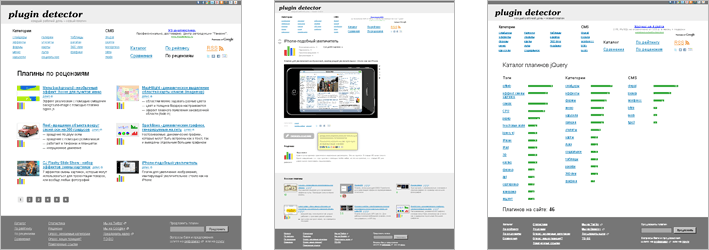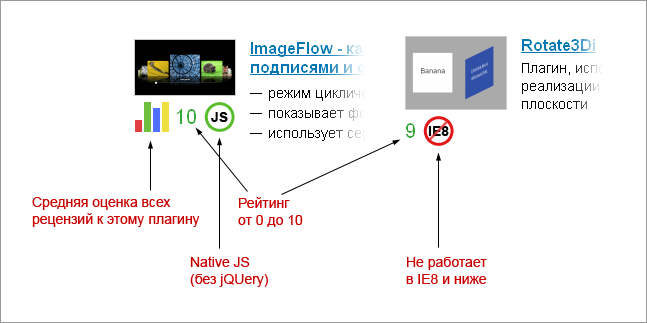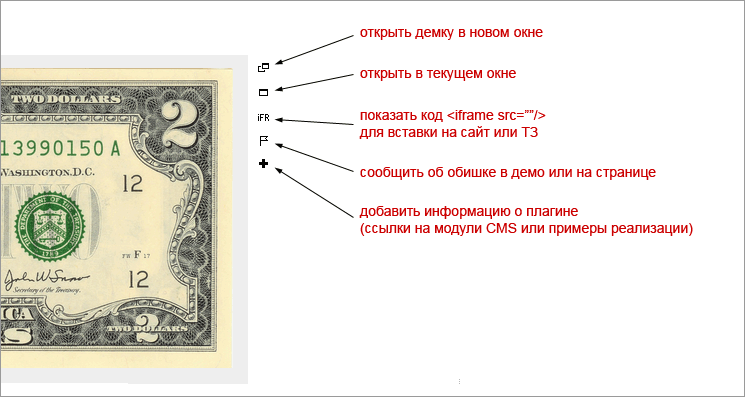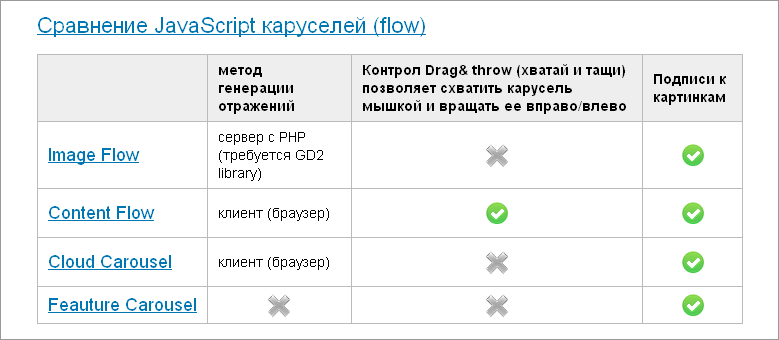Plugin Detector - jQuery plugins directory and rating
The last four years I worked as a typesetter in various St. Petersburg web studios.
From semi-basement offices of 3-5 people to large firms 25-40 people working in the market of expensive sites for large customers. But regardless of the size of the company, the tasks were the same.
Thus, the tasks for layout designers and designers were the same: “let's get something creative, fresh, interesting.”
I understand layout designers, designers and owners of web studios very well, therefore, to make it easier for them to search for plugins for ready-made functionality and at the same time show something fresh, which many others [maybe] did not see, I decided to quit everywhere and start the project Plugin Detector

This article will cover:
Feature List
There are so many jQuery plugins (several thousand on the jquery website) that their appearance and development is simply impossible to track either for a single designer or layout designer, or for the owner of a web studio. Tracking trends in jQuery plug-in engineering and putting them on a site in a blog format, while systematizing them in a catalog, is the site’s task.
Rating (up / down) You
can vote for each plug-in either for or against.
Your vote will be displayed on the statistics page .
The ratio of the votes “for” and “against” forms an average score from 0 to 10.
This vote is available to anonymous authors.

Rating by reviews
When writing a review, you need to indicate your rating on four parameters.
Writing reviews is available only to registered users (logged in via social networks)

An offer to log in to write a review:

Catalog The
catalog consists of three sections:
Catalog terms are sorted by the number of items in the term.
The numbers are already boring, they do not give clarity and, as a result, are useless.
Therefore, I decided to make a semblance of a graph.

Statistics.
In the rating of plugins by voices, I introduced the local
pie chart on canvas
written by spmbt .
He kindly agreed to use this script for free on my site.
The bars on the left show the number of votes for the plugin, and the pie chart shows the ratio of the votes for and against.
Note: the diagram does not work in older browsers

Labels for clarity
In the sections "By reviews", "By rating" and in similar plugins, snippets look like this:

Similar plugins
Similar plugins are displayed if you are on the plugin page. They are searched based on tags and categories. If the classification data is not enough to show six plugins, the missing ones are added at random.

Demo menu

Comparisons of the same type of plugins.
Sometimes the functionality that we need to implement is provided by several plugins.
Comparison tables (which will be gradually supplemented and refined)
will help to make a decision and reduce tedious procedures for studying developer sites.

If you are not tired yet;) I will tell you how the project was created
Over the past two years, I often had to dig deep into Google, looking for interesting solutions on jQuery. Then I gave designers and managers a stack of links to the next batch of selected plug-ins for their possible use in projects.
After some time, a lot of links accumulated and it became obvious that the existing plugins needed to be systematized and published somehow for easy access to company employees. So there was a closed corporate knowledge base.
I worked on the development and development of a corporate knowledge base (wiki + catalog of plug-ins) for about six months, when there was free time between projects. However, the lack of feedback from the employees (which could motivate me to further develop) made me look for other ways of development. The audience of the catalog was too small (there were about 40 people in the company, about 15 had access to the database, but used it by force of 5).
The plugin directory must be publicly available
Over time, I realized that it was not practical to make a complex base for filling which a colossal amount of time was required only for the sake of one company. I suspended the development of the corporate base and began designing a new resource open to all comers. This resource became the second version, the return to life of the idea that arose one and a half years ago. About two months were spent on developing a new version from scratch and initial filling. At the same time, I took into account design errors and used successful developments from the first version.
People don’t know that “this” is already written
Once during an interview for a layout designer, a less experienced candidate came to the office. Among other things, he showed a script that implements the rotation effect of a three-dimensional house. His samopis (I must say, well done) with the mouse could "rotate" the house.
To my question “if you knew that there is a jQuery plugin in which this functionality has already been implemented, would you write your own solution?” After a little hesitation, he replied: “I would probably use a ready-made one”. What once again made me understand - people simply do not know about the existence of a huge layer of knowledge: which plug-in can be used for what; what is it called and where does it lie.
JQuery plugins need reviews
The manager and the customer do not care what means the functionality is implemented, it is important for them to work.
For the developer, on the contrary, it is he who often chooses the implementation method (at least, this was the case in the companies where I worked). Therefore, in reviews, the developer can find valuable experience using the plugin by others, can learn about the "underwater rake" in advance, and share a comment or comment about the plugin with others. Compare the pros and cons of the two plugins before downloading and unpacking the source from the developer's site ... I think it's just cool. When I first started working with jQuery, I killed a lot of time simply because no one prompted or directed, and the search did not give an exhaustive answer on what and how best to do.
Marketing
However, this resource will be useful not only for layout designers and designers. Managers, studio owners, as well as customers themselves or website owners can use it in order to know what opportunities the modern web industry provides them. The customer can independently familiarize himself with the materials of the site to go to the developer and say: “I want this thing!”.
In some cases, there is nothing wrong with the fact that the customer himself can find the plug-in and ask him to implement it.
The project manager is always happy when the customer finally understood what he wants. And this is not even about the formal approval of models and TK, but about the real satisfaction of the fundamental needs of the customer and his business. Even when everything is approved ten times, designed, laid out and programmed, the customer can suddenly realize that he really wants to ... redo everything! And this happens not because the customer is so bad, but because the understanding of what he wants comes when he sees something ready already.
To reduce the likelihood of such "insights", I suggest giving the customer a link to the site before the first layouts are approved. So that he looked at possible options, compared the differences, “realized” this and made a more meaningful choice under the strict guidance of the developer himself.
Is it necessary to give the customer freedom of choice?
On the one hand, the customer likes to choose and feel like a participant in the process. This gives him joy and helps to facilitate the process of parting with money. On the other hand, the customer does not always understand whether the plugin is appropriate in any particular context, and a thoughtless “want” can negatively affect the final quality of the site.
Why is it profitable to use plugins?
Plugins are ready for use: screwing the plug-in to the layout and the engine is a relatively small task compared to its fundamental development. You spend relatively few resources to implement the plugin, but you get a positive effect (satisfied customer, interesting portfolio) that far exceeds these costs.
The choice of a plugin for a customer is his creativity, his contribution, which costs you almost nothing, because the choice takes place at a stage when nothing has been done. Right?
PS
If you see a cool example on the Internet and want to find out how it was done
or by what means you can implement this
(if you are not comfortable with the original tool)
- write to me by mail or by any other means.
My bookmarks have a lot of links to plugins that I have not published yet,
but have already performed primary tests.
PPS
The site has not yet been designed for monitors 1024 px wide (according to statistics of 4-5%), but in the future I will try to fix it. However, it must be borne in mind that some demos are more than a thousand wide. I didn’t look - do not blame me. Later tightened nine, scored by eight.
UPD1
updated voting resultsby profession:

voting results for the desired categories on the site:

UPD2
Disruptions to the site have been fixed, see comments below
Now I keep the shell open to clear access.log before it fills all the disk space
From semi-basement offices of 3-5 people to large firms 25-40 people working in the market of expensive sites for large customers. But regardless of the size of the company, the tasks were the same.
- need to sell design
- make a site that is not ashamed to put in a portfolio
- do original, as competitors have not done
Thus, the tasks for layout designers and designers were the same: “let's get something creative, fresh, interesting.”
I understand layout designers, designers and owners of web studios very well, therefore, to make it easier for them to search for plugins for ready-made functionality and at the same time show something fresh, which many others [maybe] did not see, I decided to quit everywhere and start the project Plugin Detector

This article will cover:
Feature List
- working demo - right on the site! no need to go anywhere to see how it works
- reviews and ratings provide a more complete picture of the plugin before installing it
- for most plugins there are links to examples of implementation in real projects
- catalog with categories, tags and CMS (plugins tailored for a specific CMS)
- RSS of the whole site; RSS for each category and tag
- each demo has a short and understandable address that can be sent via ICQ or inserted iframe
There are so many jQuery plugins (several thousand on the jquery website) that their appearance and development is simply impossible to track either for a single designer or layout designer, or for the owner of a web studio. Tracking trends in jQuery plug-in engineering and putting them on a site in a blog format, while systematizing them in a catalog, is the site’s task.
Short description of functionality
Rating (up / down) You
can vote for each plug-in either for or against.
Your vote will be displayed on the statistics page .
The ratio of the votes “for” and “against” forms an average score from 0 to 10.
This vote is available to anonymous authors.

Rating by reviews
When writing a review, you need to indicate your rating on four parameters.
Writing reviews is available only to registered users (logged in via social networks)

An offer to log in to write a review:

Catalog The
catalog consists of three sections:
- Tags
- Categories
- CMS
Catalog terms are sorted by the number of items in the term.
The numbers are already boring, they do not give clarity and, as a result, are useless.
Therefore, I decided to make a semblance of a graph.

Statistics.
In the rating of plugins by voices, I introduced the local
pie chart on canvas
written by spmbt .
He kindly agreed to use this script for free on my site.
The bars on the left show the number of votes for the plugin, and the pie chart shows the ratio of the votes for and against.
Note: the diagram does not work in older browsers

Labels for clarity
In the sections "By reviews", "By rating" and in similar plugins, snippets look like this:

Similar plugins
Similar plugins are displayed if you are on the plugin page. They are searched based on tags and categories. If the classification data is not enough to show six plugins, the missing ones are added at random.

Demo menu

Comparisons of the same type of plugins.
Sometimes the functionality that we need to implement is provided by several plugins.
Comparison tables (which will be gradually supplemented and refined)
will help to make a decision and reduce tedious procedures for studying developer sites.

If you are not tired yet;) I will tell you how the project was created
How it all started
Over the past two years, I often had to dig deep into Google, looking for interesting solutions on jQuery. Then I gave designers and managers a stack of links to the next batch of selected plug-ins for their possible use in projects.
After some time, a lot of links accumulated and it became obvious that the existing plugins needed to be systematized and published somehow for easy access to company employees. So there was a closed corporate knowledge base.
I worked on the development and development of a corporate knowledge base (wiki + catalog of plug-ins) for about six months, when there was free time between projects. However, the lack of feedback from the employees (which could motivate me to further develop) made me look for other ways of development. The audience of the catalog was too small (there were about 40 people in the company, about 15 had access to the database, but used it by force of 5).
The plugin directory must be publicly available
Over time, I realized that it was not practical to make a complex base for filling which a colossal amount of time was required only for the sake of one company. I suspended the development of the corporate base and began designing a new resource open to all comers. This resource became the second version, the return to life of the idea that arose one and a half years ago. About two months were spent on developing a new version from scratch and initial filling. At the same time, I took into account design errors and used successful developments from the first version.
People don’t know that “this” is already written
Once during an interview for a layout designer, a less experienced candidate came to the office. Among other things, he showed a script that implements the rotation effect of a three-dimensional house. His samopis (I must say, well done) with the mouse could "rotate" the house.
To my question “if you knew that there is a jQuery plugin in which this functionality has already been implemented, would you write your own solution?” After a little hesitation, he replied: “I would probably use a ready-made one”. What once again made me understand - people simply do not know about the existence of a huge layer of knowledge: which plug-in can be used for what; what is it called and where does it lie.
JQuery plugins need reviews
| - why do the “plugins” of chrome, fox, iphone and android have reviews (reviews), but do jQuery plugins not have them? Really unfair - I thought and decided to fix this flaw. |
The manager and the customer do not care what means the functionality is implemented, it is important for them to work.
For the developer, on the contrary, it is he who often chooses the implementation method (at least, this was the case in the companies where I worked). Therefore, in reviews, the developer can find valuable experience using the plugin by others, can learn about the "underwater rake" in advance, and share a comment or comment about the plugin with others. Compare the pros and cons of the two plugins before downloading and unpacking the source from the developer's site ... I think it's just cool. When I first started working with jQuery, I killed a lot of time simply because no one prompted or directed, and the search did not give an exhaustive answer on what and how best to do.
Marketing
However, this resource will be useful not only for layout designers and designers. Managers, studio owners, as well as customers themselves or website owners can use it in order to know what opportunities the modern web industry provides them. The customer can independently familiarize himself with the materials of the site to go to the developer and say: “I want this thing!”.
In some cases, there is nothing wrong with the fact that the customer himself can find the plug-in and ask him to implement it.
The project manager is always happy when the customer finally understood what he wants. And this is not even about the formal approval of models and TK, but about the real satisfaction of the fundamental needs of the customer and his business. Even when everything is approved ten times, designed, laid out and programmed, the customer can suddenly realize that he really wants to ... redo everything! And this happens not because the customer is so bad, but because the understanding of what he wants comes when he sees something ready already.
To reduce the likelihood of such "insights", I suggest giving the customer a link to the site before the first layouts are approved. So that he looked at possible options, compared the differences, “realized” this and made a more meaningful choice under the strict guidance of the developer himself.
Is it necessary to give the customer freedom of choice?
On the one hand, the customer likes to choose and feel like a participant in the process. This gives him joy and helps to facilitate the process of parting with money. On the other hand, the customer does not always understand whether the plugin is appropriate in any particular context, and a thoughtless “want” can negatively affect the final quality of the site.
Why is it profitable to use plugins?
Plugins are ready for use: screwing the plug-in to the layout and the engine is a relatively small task compared to its fundamental development. You spend relatively few resources to implement the plugin, but you get a positive effect (satisfied customer, interesting portfolio) that far exceeds these costs.
The choice of a plugin for a customer is his creativity, his contribution, which costs you almost nothing, because the choice takes place at a stage when nothing has been done. Right?
I continue to think about how to help the customer determine their desires, and that this "definition" does not cause a headache for developers
PS
If you see a cool example on the Internet and want to find out how it was done
or by what means you can implement this
(if you are not comfortable with the original tool)
- write to me by mail or by any other means.
My bookmarks have a lot of links to plugins that I have not published yet,
but have already performed primary tests.
PPS
The site has not yet been designed for monitors 1024 px wide (according to statistics of 4-5%), but in the future I will try to fix it. However, it must be borne in mind that some demos are more than a thousand wide. I didn’t look - do not blame me. Later tightened nine, scored by eight.
UPD1
updated voting resultsby profession:

voting results for the desired categories on the site:

UPD2
Disruptions to the site have been fixed, see comments below
Now I keep the shell open to clear access.log before it fills all the disk space
